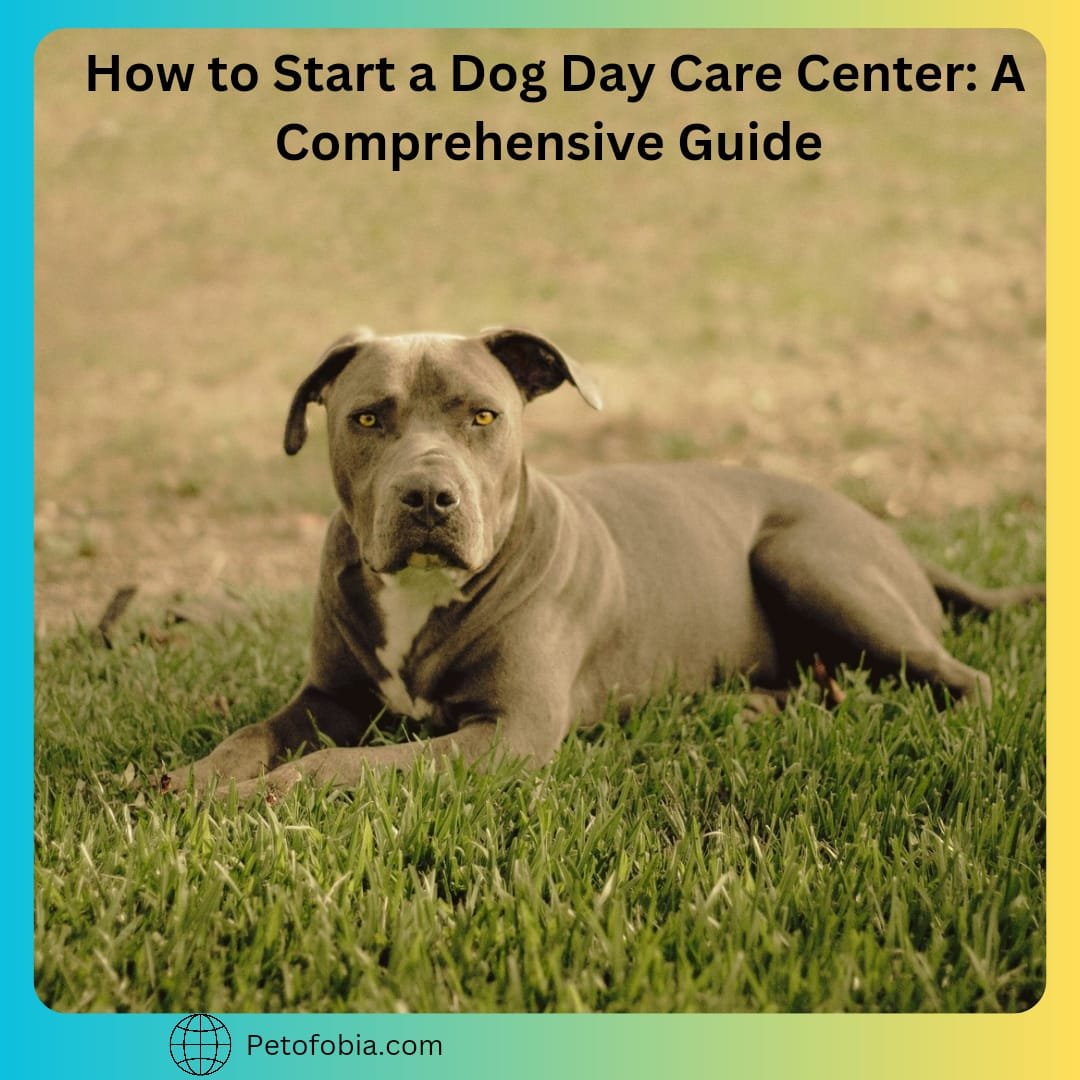
Are you a dog lover and thinking about converting your love into a successful business? Establishing a dog daycare facility may be rewarding and financially successful, giving pet owners peace of mind and a safe and fun place for their furry friends. In this blog, we will completely discuss “How to Start a Dog Daycare Center: A Comprehensive Guide.”
Table of Contents
ToggleUnderstanding the Dog Daycare Industry
The Growing Demand for Dog Day Care
As more people resume their hectic lives along with their office jobs, there is an increased need for trustworthy dog day care providers. Pet owners want for stimulating, safe spaces during the day where their dogs may interact with others, exercise, and receive care. Pet services, including creche, are a multibillion-dollar sector in the United States alone, according to the American Pet Products Association (APPA), demonstrating a significant market presence.
Advantages of Beginning a Dog Nursery
Passion-Driven Business: Make a living off of your love of dogs.
Recurring Revenue: To guarantee consistent revenue, day care facilities frequently charge a daily or membership fee.
Impact on the Community: Improve canine welfare while offering pet owners a useful service.
Market Research and Business Planning
Conducting Market Research
It’s critical to comprehend your local market before taking any action:
- Determine Rivals: Examine the current dog day care facilities in your community. What kinds of services do they provide? What are their advantages and disadvantages?
- Recognise Your Audience: Find out the characteristics of the pet owners in your area. Do you have enough potential customers to keep your business going?
- Evaluate the Demand: Determine the need for more nursery services. Focus groups, surveys, and internet research can all be useful.
Developing a Business Plan
An executive summary is a synopsis of your business idea.
- Company Description: Comprehensive details regarding your nursery facility.
- Market Analysis: What your market research has shown.
- Organisation and Management: Your company’s organisational structure and management group.
- Products and Services: A summary of the services provided.
- Marketing and Sales Strategy: Your approach to drawing in and keeping clients.
- Financial Projections: Approximated revenue, profit margins, and start up costs.
- Funding Requirements: Describe your financial requirements if you’re looking for investment.

Legal Requirements and Licensing
Business Structure
Choose a legal structure that fits your needs:
- Sole Proprietorship: Simplest form but offers no personal liability protection.
- Limited Liability Company (LLC): Offers liability protection and flexibility.
- Corporation: More complex structure with potential tax benefits.
Consult with a legal professional to determine the best structure for your situation.
Licensing and Permits
Location-specific requirements differ, but common licenses consist of:
- Business licence: Necessary for lawful operation.
- Having an animal welfare licence verifies that you adhere to strict guidelines for caring for animals.
- Zoning permits verify that your place is zoned for nursery facilities.
- Inspections for health and safety: Consistent inspections to uphold standards.
Insurance
Make sure your company is covered by the right insurance:
- Accidents and injuries are covered by general liability insurance.
- Property insurance safeguards your material possessions.
- Insurance for Workers’ Compensation: Needed if you have employees.
- Errors and omissions in services are covered by professional liability insurance.
Location and Facility Setup
Choosing the Right Location
For visibility and accessibility, location is essential:
- Make sure there is convenient access for dog owners to drop off and pick up their pets.
- Visibility: A site with plenty of foot traffic or signage may draw in walk-in customers.
- Sufficient indoor and outdoor space to support a range of dog activities is needed.
Designing Your Facility
Establish a secure and stimulating environment:
- Reception Area: A warm and inviting area for customers and their dogs.
- Play Areas: To avoid confrontations, give little and large dogs their own areas.
- Dogs can rest in quiet areas designated as sleeping areas.
- Exercise Spaces: Safe outdoor locations designated for exercise.
- Sanitation Facilities: Appropriate methods for disposing of garbage and for Day care Industry.
Equipment and Supplies
Purchase high-quality gear to guarantee comfort and security:
- Individual dogs can have secure and cosy quarters in kennels and crates.
- Toys and enrichment materials: Encourage both physical and mental exercise.
- Cleaning supplies: Uphold hygienic practices.
- Fencing and gates: safe limits to control dog mobility.
Services Offered
Core Service
- Nursery: During the day, play and care are supervised.
- Overnight Boarding: Options for Pet Owners Travelling with Extended Care.
- Training Plans: Specialised training sessions or fundamental obedience instruction.
- Services for Grooming: bathing, cutting, and other requirements.
Additional Services
- Pick-Up and Drop-Off: Suitable for time-pressed pet owners.
- Special Diets: Providing food for dogs with certain dietary needs.
- Veterinary Services: Health exams on-site or in collaboration with nearby veterinarians.
- Pet photography is the practice of taking expert pictures of clients’ animals.

Staffing Your Dog Daycare
Hiring Qualified Staff
Hiring competent and enthusiastic employees is crucial:
- Experience working with dogs: Previous dog-care training or certification.
- Instruction: Give your day care’s staff thorough instruction on all of the procedures.
- Background investigations: Make certain that all staff members and dogs are safe and secure.
Staff Roles
- Nursery Manager: Managing workers and day-to-day activities.
- Attendants at kennels: Engage directly with and tend to the dogs.
- Trainers and groomers: offer specialist services as required.
- Administrative Staff: Take care of billing, reservations, and customer support.
- Competitive Salaries: Attract and retain skilled employees.
- Ongoing Training: Keep staff updated on best practices and safety protocols.
- Team Building: Foster a collaborative and supportive workplace culture.
Safety and Health Standards
Establishing Safety Protocols
Make sure all dogs and employees are safe:
- Health Screening: Demand immunisation records and client health clearances.
- Emergency Protocols: Establish protocols for handling medical crises and natural calamities.
- Supervision: Keep the right staff-to-dog ratios in place to keep an eye on interactions.
- Behaviour Assessments: To avoid disputes, assess the temperaments of dogs prior to admission.
Maintaining Cleanliness
Keeping oneself clean is essential to stopping the spread of illness:
- Frequent Cleaning: Establish daily schedules for cleaning every space.
- Disinfection: Sanitise toys and surfaces with disinfectants that are safe for pets.
- Waste Management: To keep the environment clean, dispose of pet waste properly.
Health and Wellness
Improve the dogs’ well-being by:
- Nutrition: Serve fresh water and well-balanced meals.
- Exercise: Make certain that pets get enough exercise.
- Mental Stimulation: To keep people from getting bored, provide toys, puzzles, and social activities.
·
Marketing and Building Your Clientele
Developing a Strong Brand
Build a unique identity identity:
- Name and Logo: Select a memorable name and a polished logo.
- Mission Statement: Make your services and values very apparent.
- Keep your branding consistent by keeping all of your marketing materials the same.
Online Presence
Use digital channels to connect with prospective customers:
- Website: Establish a user-friendly website that includes facts about services, costs, and how to get in touch with you.
- Social media: Use sites like Facebook, Instagram, and Twitter to interact with the community.
- Online Reviews: Request that pleased customers post favourable reviews on Yelp and Google.
Local Marketing Strategies
Establish a connection with your community:
- Networking: Exchange recommendations with nearby groomers, pet shops, and vets.
- Events: Conduct training sessions, pet adoption events, or open houses.
- Advertising: Make use of community boards, fliers, and local media.
Customer Retention
Develop a devoted customer:
- Membership programs: Provide loyal consumers with benefits or discounts.
- Tailored Service: Recall the preferences and unique requirements of your clientele.
- Input: To enhance services, always seek out and respond to client input.

Financial Planning and Budgeting
Estimating Start-up Costs
Understand the amount you must invest initially:
- The cost of facility rent or lease varies according on size and location.
- Renovations and Setup: The cost of planning and furnishing your facility.
- Licensing and Permits: The cost of acquiring the required licenses.
- Supplies and Equipment: Toys, cleaning supplies, kennels, etc.
- Marketing: The initial outlay for branding and advertising.
- Staffing: Pay for training and salaries.
Project Ongoing Expenses
Budget for ongoing operating expenses:
- Rent and Utility Bills: Your facility’s monthly payments.
- Salaries: Constant pay for your employees.
- Insurance: Consistent premium payments.
- Supplies: Constantly buying food, cleaning supplies, and toys.
- Maintenance: The upkeep of infrastructure and machinery.
Financial Management
Maintain an excellent financial situation:
- Accounting Software: For bookkeeping, use programs like Xero or QuickBooks.
- Budgeting: Keep an eye on spending and make any required adjustments to stay profitable.
- Cash Flow Management: Make sure you have sufficient cash on hand to pay for continuing expenses.
- Financial Reporting: Monitor performance by periodically reviewing financial statements.
Ongoing Operations and Management
Daily Operations
Make your daily tasks more efficient:
- Check-In/Check-Out Procedures: Handle customer arrivals and departures with efficiency.
- Scheduling: To ensure maximum efficiency, arrange worker shifts and dog activities.
- Keeping Records: Keep thorough records of the health, habits, and preferences of every dog.
Customer Service
Deliver an extraordinary service to retain clients:
- Communication: Keep clients informed about their pets’ day.
- Problem Resolution: Address any concerns promptly and professionally.
- Personal Touch: Send updates, photos, or newsletters to engage with clients.
Conclusion
It takes meticulous preparation, a sincere love of dogs, and a dedication to offering the best care possible to open a dog daycare facility. You may build a reliable and prosperous company in the booming pet care sector by carrying out in-depth market research, following safety and regulatory regulations, and putting up strong marketing plans. Recall that the secret to sustained success is giving the dogs you look after a secure, stimulating, and loving atmosphere so that both the animals and their owners are content and fulfilled over the long run.
Set off on this wonderful adventure to transform your love of dogs into a successful business!






